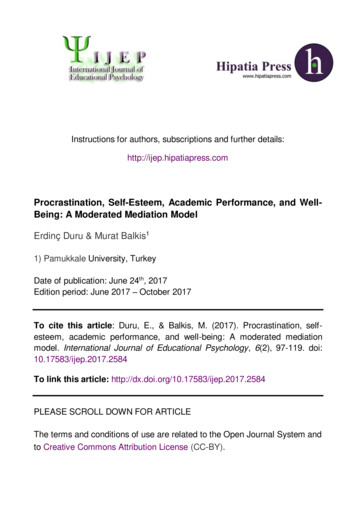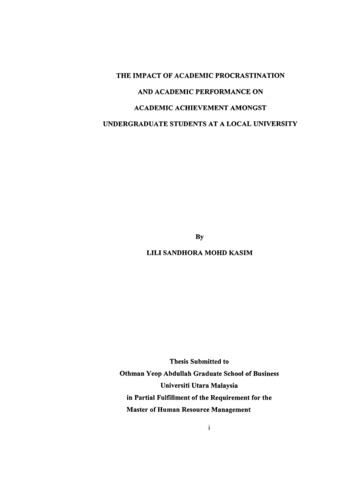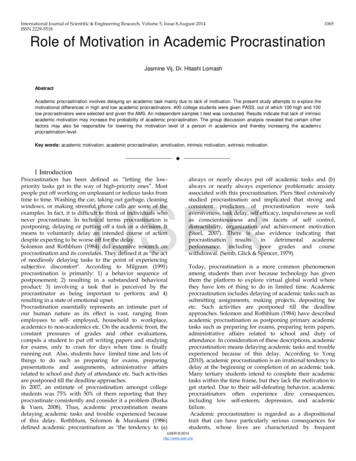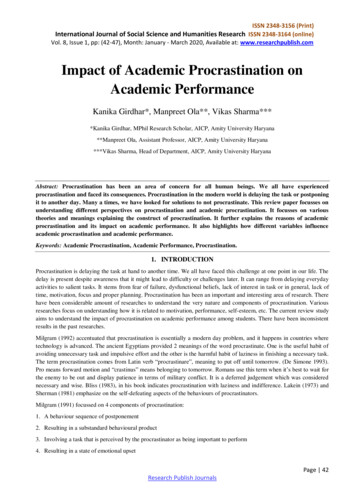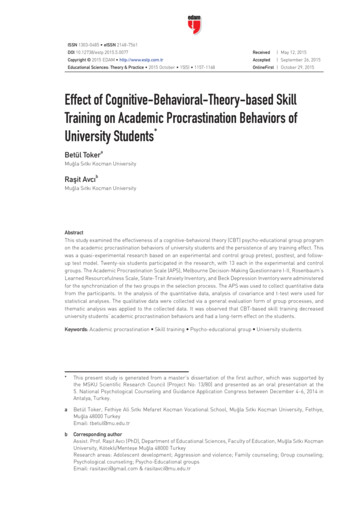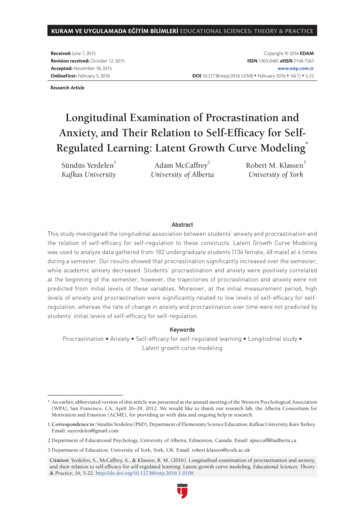
Transcription
Journal of Education and Training StudiesVol. 5, No. 9; September 2017ISSN 2324-805XE-ISSN 2324-8068Published by Redfame PublishingURL: http://jets.redfame.comThe Relation between Academic Procrastination of University Students andTheir Assignment and Exam Performances:The Situation in Distance and Face-to-Face Learning EnvironmentsM. Betul YilmazCorrespondence: M. Betul Yilmaz, Yildiz Technical University, Faculty of Education, Computer Education andInstructional Technologies Department, Istanbul, Turkey.Received: July 18, 2017doi:10.11114/jets.v5i9.2545Accepted: August 16, 2017Online Published: August 17, 2017URL: https://doi.org/10.11114/jets.v5i9.2545AbstractThe relation between assignment and exam performances of the university students and their academic procrastinationbehaviors in distance and face-to-face learning environments was investigated in this study. Empirical research carriedout both in face-to-face and online environments have generally shown a negative correlation between academicprocrastination and academic performance. However, the effect of academic procrastination on assignments in distancelearning setting has not been analyzed extensively. To understand the interaction between academic procrastination andthe learning environment; assignment and exam performances of eighty-eight university students in face-to-face (FtF)and distance learning (DL) environments were investigated. According to the findings of the study, students’ academicprocrastination and assignment scores were negatively correlated in both environments but especially in DL setting.Contrary to this, academic procrastination and exam scores were correlated to each other only in FtF environment. Onthe other hand, there was no correlation between total assignment and exam scores for DL group, while a mediumpositive correlation was found in FtF group. The findings of binary logical regression analysis demonstrated thatpredictive value of the DL environment for assignment score is much stronger than academic procrastination behaviorof students.Keywords: academic procrastination, formative assessment, assignment performance, distance learning universitystudents1. Introduction1.1 Introduce the ProblemIn the last few decades, there has been an evolution from face-to-face learning-teaching environments to technologyintegrated face-to-face, blended, distance and open learning environments. Despite this shift, fundamental phases ofteaching (analysis, planning, delivering content, doing activities and evaluation) continue to take place in all of theseenvironments. Regardless of the level of technology integration, students are expected to perform tasks such aspreparing term projects with deadlines, preparing for exams, or completing daily or weekly reading assignments (UzunÖzer, 2009). Assignments can be seen as a tool to shape how much, how, and what (the content) students learn (Scouller,1998). Fulfilling these tasks with deficiencies or not being able to complete them before the deadline often results inpoor academic performance. Academic procrastination is one of the factors that causes this situation (Akinsola, Tella, &Tella, 2007; Asarta & Schmidt, 2013; Balkıs, Duru, Buluş, & Duru, 2006; Klingsieck, Fries, Horz, & Hofer, 2012;Michinov, Brunot, Le Bohec, Juhel, & Delaval, 2011, Moon & Illingworth, 2005, Perrin et al., 2011; You, 2015).Procrastination refers to ‘the lack of intention or willingness to take action’ (Ryan & Deci, 2000 as cited in Rakes &Dunn, 2010, p. 80) that is typically observed in the form of intentional and habitual delay of tasks (Elsworth, 2009). Itindicates a discrepancy between a person’s intention to take action and the observed performance of that action (Blunt& Pychyl, 2005). Steel (2007, p.66) defines procrastination as ‘to voluntarily delay an intended course of action despiteexpecting to be worse off for the delay’.Recently, there has been ample research on procrastination, which is a pervasive phenomenon (Klingsteick, Fries, Horz& Hofer, 2012). Academic procrastination in schools is frequently observed in tasks such as preparing for examinations,doing homework, and completing projects. Steel (2007) found that more than 80% of undergraduate students are146
Journal of Education and Training StudiesVol. 5, No. 9; September 2017involved in procrastination and up to 50% of them are consistent procrastinators. It is estimated that this rate isapproximately 50% in Turkish university students (Uzun Özer et al., 2009). To make things worse, the Internet is apowerful attention distractor owing to its online and entertaining applications (Thatcher, Wretschko, & Fridjhon, 2008).Parallel to the changing technology and learning environments, procrastination in e-learning requires special attention(You, 2015).1.2 Explore Importance of the ProblemAcademic success for undergraduates is linked to study goals and effective management of study time (Stewart, Stott, &Nuttall, 2016). You (2015) reports that late submission or absence of assignments is related to low level courseachievement. Contribution of assignments in learning as a formative assessment tool is non-negligibly valuable.However, they may not be seen as important as exams by students when it comes to passing the course. Making the bestof assignments given for formative assessment purposes should be considered as an opportunity by students to see andcomplete their weaknesses and improve what they learn. Assignments should be managed accurately in order to providemaximum efficiency during the learning process. Nonetheless, studies on procrastination have focused on the causes ofthis behavior and to some degree how it is related to school achievement; however, assignment achievement has notbeen fully researched (Hong & Milgram, 2000). For this reason, correlation of academic procrastination withassignment and exam performances of students in different learning environments is the focus of this research.1.3 Literature ReviewProcrastination is common in academic contexts, especially in environments where students have to meet deadlines forassignment completion, which necessitates students’ time and concentration (Gafni & Geri, 2010). This situationrequires students to manage their time constantly throughout the semester. Inadequate self-regulation, which manifestsitself as procrastination, is connected to a variety of negative study behaviors (Stewart, Stott, & Nuttall, 2016). However,since procrastinators have relatively short amounts of time for fulfilling tasks, they rush to complete their work (You,2015). Indeed, in his meta-analysis of procrastination research, Steel (2007) reported that strong, consistent predictorsof procrastination appeared in the forms of task aversion and task delay. Similarly, Balkıs, Duru, Buluş, & Duru (2006)demonstrated that negative time management is among the significant predictors of academic procrastination tendency.On the other hand, procrastination does not simply result from a deficit in time management or ineffective study habits;it involves a complicated interaction among behavioral, affective, and cognitive elements (Rothblum, 1994 as cited inRakes & Dunn, 2010)). One of the most commonly encountered components among them is self-regulation. From aconceptual viewpoint, procrastination and self-regulation are closely related constructs (Tuckman, 2005). Theinclination to procrastinate is very frequently attributed to an insufficiency in self-regulation processes (Michinov et al.,2011; Yamada et al, 2016). Elsworth (2009) reports that conceptualizations of procrastination resulting fromself-regulation failure have been substantially supported by empirical research. For example, in his comparative studywith high, moderate, and low procrastinators; Tuckman (2002) found a negative correlation between self-regulation andprocrastination; the more the students were self-regulated, the less they procrastinated. Similarly, in their study, Rakes &Dunn (2010) found that when students lack intrinsic motivation to learn and have diminished self-regulation, there is anincrease in procrastination.Schunk and Zimmerman (1998 as cited in Rakes & Dunn, 2010) suggest that self-regulated learning strategies shouldbe more important considering the increasing number of students’ participation in distance learning environments whereinstructors do not physically teach. These environments require more autonomous students (Rakes & Dunn, 2010) andin these environments, teachers should be aware of the tendency of their students to procrastinate (Delaval, Michinov,Le Bohec, & Le Hénaff, 2017). McElroy & Lubich, (2013, p. 85) states that ‘the nature of online classrooms increasesthe need for students to have greater intrinsic motivation and to initiate the learning process, thereby exacerbating thetendency to delay for many students in online classrooms’.Regarding the procrastination and achievement, both coherent and contradictory findings are seen in literature in DLsetting. For example, the study by Michinov et al. (2011) demonstrated that learners who are most likely to procrastinateare the ones who perform the worst in online learning environments. Yet, in another study, while procrastination in onlinesections was negatively correlated with exam scores, the same correlation was not observed in FtF sections (Elvers,Polzella, & Graetz, 2003). However, in another study by Romano et al. (2005), all students followed the same classsyllabus and schedule, and they took the same objective-style examinations in distance and blended learning. According tothe findings of their study, ‘students with live instructors (blended) and less transactional distance tended to procrastinatemore than total distance students with greater transactional distance’ (Romano et al., 2005, p. 303). Their findingscontradict with the expectations based on transactional distance (see: Moore & Kearsley, 2011).Since online students do not meet with their peers and instructors in regular classes, they are more likely toprocrastinate and squeeze more work into less time, which leads to less effective outcomes (Rakes & Dunn, 2010). It147
Journal of Education and Training StudiesVol. 5, No. 9; September 2017appears as if students perceive such unstructured distance-learning environment as an excuse to procrastinate(Klingsieck, Fries, Horz, & Hofer, 2012). There has been more research on procrastinating and non-procrastinatingstudents in online, blended and face-to-face environments in the last decade (Geri, Gafni, & Winer, 2014; Klingsieck,Fries, Horz, & Hofer, 2012; Michinov et al., 2011; Rakes & Dunn, 2010; Romano, Wallace, Helmick, Carey, & Adkins,2005; Yamada et al., 2015; You, 2015). Some part of these studies shows that procrastinators are more disadvantagedthan non-procrastinators in DL in terms of their academic achievement.The students, who have the habit of procrastination, usually deliver the assignment on time; however, they manage thiswith an increasing performance towards the end of the time instead of using time effectively (Steel, 2002). For thisreason, chronic and academic procrastination are often connected with detrimental behaviors and outcomes such as lowacademic performance (Uzun Özer, Demir, & Ferrari, 2009), submission of assignments after the deadline andcramming (Klassen, Krawchuk, & Rajani, 2008).1.4 Research ProblemsDepending the literature and the importance of the study, the following research problems have been raised:1. Is there a correlation between academic procrastination scores and total assignment scores of students in face-to-faceand distance learning environments?2. Is there a correlation between academic procrastination scores and exam scores of students in face-to-face anddistance learning environments?3. Is there a predictive relation between academic procrastination, total assignment, and exam scores of students indistance learning environments?2. MethodWithin the following chapter, the information on how the study was conducted is provided, including descriptions of theparticipants, data collection tools and the procedure.2.1 Research DesignIn this study, comparative survey method was employed as a descriptive research design model. Two different learningenvironments were arranged for the course in which the study was conducted: face-to-face (FtF) (group 1) and distancelearning (DL) (group 2). The research was conducted for 15 weeks. In each group, participants’ academicprocrastination behaviors, assignment scores, and exam scores were used as independent variables.2.2 Participant CharacteristicsParticipants of the research were students at Faculty of Education, Computer and Instructional Technologies EducationDepartment of a state university in Istanbul, Turkey and taking "Information Technologies in Education I" course during2015-2016 academic year. Course content included usage of presentation, word processing, and electronic worksheetprograms for educational purposes. Since 12 out of 100 students enrolled in the course were excluded from the studydue to incompletion of the course and unwillingness to complete the data collection tool, a total of 88 studentsparticipated in the study. 79 (89.8%) of the students were freshmen, eight (9.1%) of them were sophomores and one ofthem (1.1%) was junior. 32 of the participants (36%) were female and 56 of them (64%) were male. Ages of studentsranged from 17 to 30 and the mean age was 19.3.2.3 ProcedureAs mentioned before, FtF (group 1) and DL (group 2) environments were arranged for the course in which the studywas conducted. Participants of the study enrolled in one out of the two different groups of the course over the studentmanagement system of the university at the beginning of semester. Whether the courses would be given FtF or throughDL was shared with the students prior to enrollment. Only 12 of the students in the second group stated that theyparticularly wanted to receive the course online. However, 28 students had to take the course in DL environment owingto the full capacity of FtF course. Students took other courses together in FtF environment during the semester.The course content included using presentation, word processing and electronic worksheet programs, and outcomesregarding using these programs were determined. Both groups followed the same syllabus and were delivered the samecontent concurrently week by week. The content also consisted drill and practice activities related to the outcomes. Theseactivities had been done by group 1 students in the computer lab. Students in group 2 did the same activities on the LMS.The first group took the course in a FtF environment at computer lab and feedbacks for drill and practice activities weresupplied promptly. Course was scheduled to be 2 hours per week for this group. The second group took the course inDL environment. In this group, course materials prepared as videos, visual aided texts, and presentation files weredelivered to the students by allowing access on a weekly basis via learning management system (LMS). The148
Journal of Education and Training StudiesVol. 5, No. 9; September 2017recommended time to spend on online course materials was approximately two hours per week as well. As a limitationof the study, there were no live classrooms or active discussion boards to allow interaction between students in DLenvironment. Students in group 2 asked their questions and were responded via LMS, although feedback demands veryoccasionally occurred in this group.Students taking the course were requested to send four different assignments (in a manner not to exceed deadlines)related to course content through electronic mail (group 1) or by uploading them to LMS (group 2) through the semester.For assessments, no questions were allowed and no feedback was provided in both groups before deadline. At the end ofthe semester, students in both groups took a hands-on exam at the same day and same place. Students were told thattheir scores from the assignments and exam would be reflected in their passing scores in equal weights.2.4 Data Collection ToolsThe first data collection tool used in this research is the “Academic Procrastination Scale” developed by Çakıcı (2003).The Academic Procrastination Scale is a five point Likert scale consisting of 19 items with seven reverse items. Scorerange for the scale is 19-95 and high score means high academic procrastination behavior. Cronbach alpha (α)coefficient for internal consistency of the original scale has been calculated as .92 (Çakıcı, 2003). Cronbach alpha (α)has been found as .91 in this study. The scale was administered to students at the beginning of the procedure and tookaround seven minutes to complete.The second data collection tool consisted of four different assignments developed according to the outcomes of thecourse. One of the assignments was creating a presentation, two of them involved using word processing, and one ofthem required using electronic worksheet programs. Each assignment had a theme within its own integrity andcontained multiple behaviors related to the determined outcomes. Contents of the assignments and assignment scoringcriteria have been developed by the researcher and finalized by opinions of two expert lecturers in the field.Assignments were announced to the students in both groups to be submitted electronically on pre-determined deadlines.All submitted assignments were graded by two teaching assistants according to determined scoring criteria. Maximumtotal score that can be obtained from four assignments was 100.The third data collection tool was a hands-on exam regarding presentation, word processing, and electronic worksheetprograms. The exam, which was developed by the researcher based on course outcomes, consisted of 11 questions. Fourquestions were related to presentation, four questions were related to word processing, and three of them were related tousing electronic worksheet programs. For each question, students were asked to complete some tasks on the computer,which composed of several behaviors related to programs mentioned above. An answer key was also developed in orderto guide the marking process of the exam. In the answer key, required responses were described in detail and everysteps of tasks were graded for each answer. Face and content validity of the exam was assessed and approved by twoexpert lecturers. These experts also confirmed the marking scheme of the answer key. The exams were taken in aproctored setting. Both groups were separately tested in a computer lab in the same day in successive sessions, within40 minutes in total per session. Answers given by the students were promptly scored by the researcher and two teachingassistants according the answer key during each session. The score that could be obtained from the exam rangedbetween 0 and 100.2.5 Analysis of DataSPSS 21 was used to analyze the data. Although normality requirements for academic procrastination scores were met,analyses made on total assignment scores and exam scores demonstrated non-normal negatively skewed distribution.Therefore, non-parametric tests including Mann Whitney U test, Spearman’s correlations test, and binary logicalregression analysis were performed in the study.3. ResultsIn this section, results of the statistical analyses related to research problems are presented. Descriptive statisticalanalyses were conducted prior to correlational analyses. Descriptive statistics of 48 students taking courses in FtFenvironment and 40 students taking courses in DL environment are presented in Table 1.Table 1. The descriptive statistics of academic procrastination scores, total assignment scores and exam scoresVariablesGroup 1 (FtF) (N 48)Min MaxSdGroup 2 (DL) (N 40)Min MaxAcademic Procrastination Score327649.13 10.6628Total Assignment Score0100 78.62 23.67Exam Score31100 81.17 17.9614985SdMannWhitney Upr51.99 12.49807.500.201 ,14092.63 68.06 23.98580.500.001 ,3441100 81.23 13.40858.500.508 ,14
Journal of Education and Training StudiesVol. 5, No. 9; September 2017As seen in Table 1, academic procrastination scores of the participants ranged between 28 and 85. It is remarkable thatmaximum and average values of academic procrastination scores of group 2 are higher than group 1. However, MannWhitney U test analysis demonstrated that there is no statistically significant difference between academicprocrastination scores in terms of groups (U 807.500; p .201, r 0.14).According to Table 1, average of total assignment scores of students is 78.62 for group 1 and 68.06 for group 2.Minimum score is zero (that means none of four assignments were sent within the deadline) in both groups and unlikethe students in group 1, there are no students who could take full score (100) in group 2. Mann Whitney U test analysisdemonstrated that difference between total assignment scores of the groups is statistically significant with a mediumeffect size (U 580.500; p .001, r 0.34). Regarding the results, the median score of total assignment scores decreasedfrom FtF environment to DL environment. These results raise the question of whether taking the course in DLenvironment created a negative impact on the total assignment scores of the students.Findings in Table 1 show that students’ average exam scores are 81.17 and 81.23 for group 1 and group 2, respectively.While minimum exam scores for group 1 and group 2 are 31 and 41 respectively, maximum exam score for both groupsis 100. Mann Whitney U test analysis demonstrated that there is no statistically significant difference between examscores of the groups (U -858.500; p .508, r 0.14). According to these results, average scores students obtained fromthe exam does not differentiate depending on taking the course FtF or through DL.3.1 Correlational AnalysesSpearman’s correlational analyses were carried out to understand the relations among 'academic procrastination score','total assignment score' and 'exam score' variables. Scatterplots reviewed prior to the analysis demonstrated thatlinearity requirement for each variable was satisfied. Spearman's correlation analysis was used since the values ofacademic procrastination scores in dataset did not satisfy normal distribution criteria. Results of the analyses performedindividually for group 1 and group 2 are presented in Table 2.Table 2. The correlation between academic procrastination score, total assignment score and exam scoreVariablesGroup 1 (FtF) (N 48)Group 2 (DL) (N on AssignmentProcrastination AssignmentScoreScoreScoreScoreScoreScoreAcademic Procrastination ScoreTotal Assignment ScoreExam 76-.367*.176-.216.216-*p .05 level two-tailed, **p .01 level two-tailedWhen Table 2 is examined, it can be seen that inter-correlations among three variables ranged from .244 to .589 forgroups. First and foremost, there is a negative correlation between academic procrastination and total assignment scoresfor both FtF and DL groups (rho -.30; p .05; rho -.37; p .05 respectively), furthermore this correlation is stronger forDL group than FtF group. On the other hand, correlation findings for academic procrastination and exam scores of twogroups are not concordant. While a small negative correlation (rho -.32; p .01) was found for FtF group, for DL groupthere was no significant correlation (rho .18; p .05). A similar situation was also observed for total assignment andexam scores of groups. For FtF group there was a moderate positive correlation (rho .39; p .01) between totalassignment and exam scores, yet a significant correlation (rho .22; p .05) was not found for DL group.To test the statistical significance of the difference between two groups’ correlation coefficients, the observed value of zwas calculated for each variable pairs (Pallant, 2007). As the first step in the comparison process, all rho values wereconverted to z’ values, and for each z’ pairs zobs values were calculated by using Fisher’s z-transformation formula. Theresults show that significance of the difference between two correlation coefficients in FtF and DL groups were notsignificant for academic procrastination and total assignment score peers and total assignment and exam score peers. Onthe other hand, the correlation coefficients of academic procrastination and exam scores were statistically significant forboth FtF and DL groups.These different and contradictory results in Table 2 demonstrate that in FtF environment; students’ academicprocrastination, total assignment, and exam scores are slightly related to each other. On the contrary, in DL environment,the only correlation is observed between academic procrastination and total assignment scores. Hence, it was thoughtthat academic procrastination behavior and the learning environment may predict total assignment score and thusregression analysis was performed.150
Journal of Education and Training StudiesVol. 5, No. 9; September 20173.2 Binary Logistic RegressionSince total assignment scores of participants did not exhibit normal distribution, in order to see to how independentvariables (academic procrastination: scale; learning environment: categorical) predict these scores, binary logisticregression was carried out. Binary logistic regression analysis is an alternative method to logistic regression analysisthat allows categorically and continuously scaled variables to predict any categorically scaled criterion (King, 2008). Itcan be used when the assumptions of logical regression analysis such as normality or common covariance conditionsare not met (Pallant, 2007).In order to use in binary logistic regression, the variable total assignment score which will be predicted was recodedinto categorical ‘assignment score level' variable. To this end, “mean ¼*standard deviation” was defined as thresholdto diverse 'high' ( 0) level total assignment scores, and the remaining scores were coded as 'low' ( 1). After recoding,prior to starting binary logistic regression, suitability of the dataset for this analysis was checked as summarized below.First, for all categorical variable pairs, it was ensured that frequency expected in all cells was greater than 1 and numberof cells where expected frequency was less than 5 did not exceed 20% (Çokluk, 2010). Following this, Mahalanobisdistances were calculated for academic procrastination scores, and multivariate outlier presence was sought (Pallant,2007). Depending on the number of independent variable, which is 2, it was seen that there was no outlier whoseMahalanobis distance exceeded 13.8 (Akbulut, 2010, p. 157). With regard to the values in multicollinearity diagnosistable, it was observed that tolerance values did not approach 0 (Pallant, 2007) and variable increase factors (VIF) weresmaller than 10 (Akbulut, 2010, s. 75). At the end of these controls, it was concluded that the data set was suitable forbinary regression analysis. A binary regression analysis was conducted to predict total assignment score level for 88participants, using ‘type of learning environment (group)’ and ‘academic procrastination score’ as predictors. 'Stepwiseforward' method was used to predict dependent variable in the analysis.The full model containing both predictors was statistically significant, (2, N 88) 15.799, p .001, indicating that themodel was able to distinguish between students who had and did not have high total assignment scores. Hosmer and2Lemeshow goodness-of-fit test regarding the suitability of the model ( (2, N 88) 14.290, p .05) was not concluded asignificancy (2000); therefore goodness index of the model was sufficient (Çokluk, 2010). The model as a wholeexplained between 16.4% (Cox and Snell R square) and 22.2% (Nagelkerke R square) of the variance in totalassignment score level, and correctly classified 70.5% of cases (83.0% for higher assignment score and 51.4% for lowerassignment score). R square values indicated that learning environment (group) and academic procrastination explained16.4% to 22.2% of difference for total assignment score level, which mean there is a low relationship betweenprediction and grouping. β parameters of the model obtained through this analysis and Wald statistics, degrees offreedom, significance levels and odds ratio values are given in Table 3.2Table 3. Logistic Regression Predicting Total Assignment ScoreN 88Group (1)ProcrastinationConstantβS.E.WalddfOddsSig. Ratio-1.141.4795.6731.017.062.0237.5061.193 6.241-2.97995.0% C.I for Odds RatioLowerUpper.320,125,8171.006 1.0641,0181,1121.012.051-2 log-likelihood 70,5; (1)-- internal value of FtF groupAs shown in Table 3, both learning environment (group) and academic procrastination variables made a statisticallysignificant contribution to the model (p .017; p .006 respectively). The weaker predictor of high total assignmentscore was academic procrastination, recording an odds ratio of 1.064. Odds ratio value lower than 1 indicates a negative,and higher than 1 means a positive relationship (Çokluk, 2010). Hence, when academic procrastination is raised by oneunit, the odds ratio is 1.064 times larger. This means that one unit increase in academic procrastination gets the student6.4% ((1.064-1)*100) closer to low total assignment score level (internal value 1 for the model).On the other hand, for learning environment (group) variable the odds ratio is .320 times smaller. This indicated thatstudents who participated in FtF learning environment were .32 times likely to have low total assignment score level,controlling for the other predictor in the model. In other words, students in FtF environment moved 68% ((.320-1)*100)away from low total assignment score level.In brief, the effect of FtF environment on low assignment score was 68% negative while the effect of academicprocrastination was only 6.4% positive.151
Journal of Education and
& Pychyl, 2005). Steel (2007, p.66) defines procrastination as 'to voluntarily delay an intended course of action despite . Academic success for undergraduates is linked to study goals and effective management of study time (Stewart, Stott, & . Nuttall, 2016). You (2015) reports that late submission or absence of assignments is related to .


